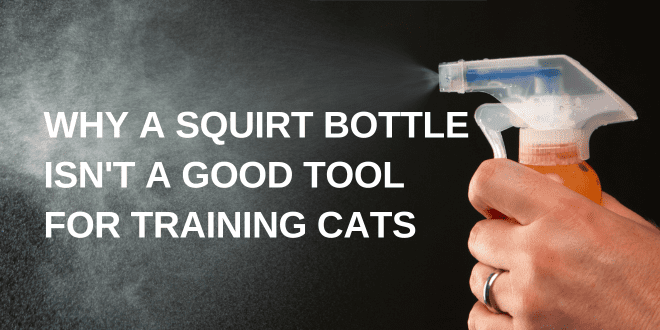
When training, the methods used need to be effective, but they also need to be positive, kind and humane. Proper training techniques result in a beneficial outcome for both the cat and the cat parent by improving communication and strengthening the bond. Conversely, aversive training methods can lead to fear, confusion, and a breakdown of trust.
One commonly used training tool when it comes to working with cats, is a squirt bottle filled with water. This is often used to deter so-called “misbehavior.” On the surface it may appear more humane and safer compared to physical discipline. Actually though, it’s ineffective and counter-productive. Here are several reasons why I don’t recommend this method:
It Doesn’t Teach the Cat an Alternative Behavior
When punishment is used, it means the cat’s behavior has been labeled as bad. Cats don’t misbehave. Behaviors are displayed because they serve a function. It doesn’t necessarily mean the cat parent likes the behavior, but punishing the cat instead of addressing the underlying need or recognizing the natural behavior doesn’t solve the problem. If the cat has a purpose for a behavior, or it’s carried out as an essential part of cat life (scratching, for example), then punishment just creates a dead end. There’s no positive outcome for either the cat or the cat parent and both just end confused and stressed. The unwanted behavior is temporarily stopped, but no real learning has taken place.
Increased Stress
Since behaviors, even those unwanted by cat parents, are performed for a reason that makes sense to the cat, the sudden attack from the squirt bottle ends up being stressful. Cats are very sensitive and if stressed out, it becomes more difficult to be open to learning. The sight of the squirt bottle may trigger the cat to seek a hiding place or avoid the cat parent. If the behavior was being displayed because of a concern or a problem, it just compounds the stress. If the cat was jumping on the counter to feel safe from another cat’s ambush, then the spray bottle only heightens anxiety. If the water was being squirted to stop the cat from scratching the sofa, then the need to scratch (which is a normal, beneficial behavior) remains unmet. The squirt bottle failed to teach the cat an appropriate alternative.
Unexpected Associations
The sight of the cat parent holding the spray bottle may create an unwanted negative association. The cat may run from the cat parent or exhibit fear at the sight of the bottle. In such cases, the only learning that occurs is that the cat has now developed a fear and learned to find an escape. There are some cats who continue to engage in the unwanted behavior, even while being sprayed in the face with water. The need for the behavior outweighs the unpleasant consequence. Talk about stressful! An additional side effect of this is that trust is undermined so the bond between cat and cat parent deteriorates.
Sometimes, the cat may make a negative connection between the squirt bottle punishment and the specific area of the home where the punishment is routinely delivered. For example, a cat parent who sprays the cat for being on the counter may find the cat becomes reluctant to enter the kitchen at all, even to eat out of his own food bowl.
Increased Aggression
The use of a squirt bottle to stop aggression between two cats will do nothing to help them develop a better association with each other. In fact, using the squirt bottle may intensify aggression.
Covert Behavior
Cats are intelligent and can learn that certain behaviors can only be performed when the cat parent is absent. If no alternative behavior has been taught or the cat’s underlying needs have not been addressed, the undesirable behavior may resume once the cat parent leaves for work or retires for the night.
Here’s a Better Training Approach
Instead of relying on punishment and squirt bottles, a more effective training approach involves understanding the purpose of the behavior and providing better alternatives. For example, if the cat jumps on the kitchen counter, identify the motivation behind the behavior. It could be the smell of food, a desire for a better view out the window, a need for elevated safety, or a bid for the cat parent’s attention. Once the underlying reason is determined, a suitable alternative can be provided. If the behavior stems from a problem in the environment, such as a cat being ambushed by another cat, positive behavior techniques should be employed to diffuse the situation. Squirting the cat with water is not part of a sound and loving training plan.
Cats respond to positive training but it’s crucial to start the process by recognizing that every behavior serves a purpose. Cats don’t misbehave out of spite or defiance. Behavior makes sense to them. Proper training strengthens the bond, restores confidence, and reduces stress.
Save the squirt bottle for misting the plants. Focus on understanding and addressing the cat’s needs.
Need More Information?
For specific information on cat behavior and training techniques, refer to the best-selling books by Pam Johnson-Bennett. The books are available at bookstores as well as online. We’ve included Amazon links here on our website.



